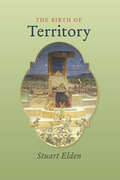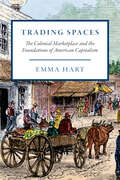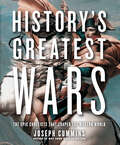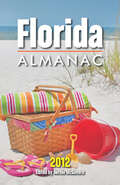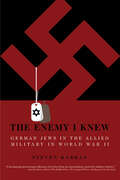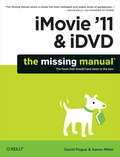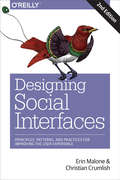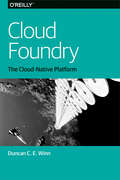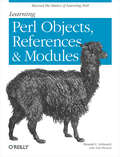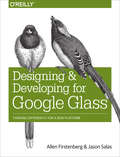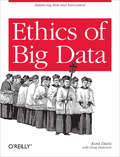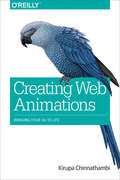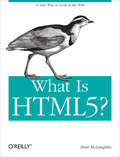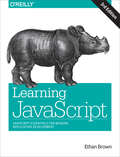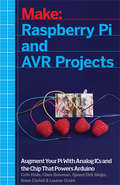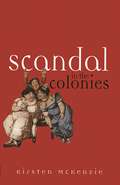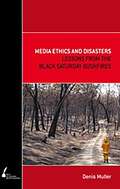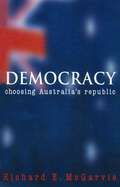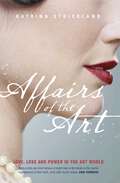- Table View
- List View
The Birth of Territory
by Stuart EldenPolitical theory professor Stuart Elden explores the history of land ownership and control from the ancient to the modern world in The Birth of Territory.Territory is one of the central political concepts of the modern world and, indeed, functions as the primary way the world is divided and controlled politically. Yet territory has not received the critical attention afforded to other crucial concepts such as sovereignty, rights, and justice. While territory continues to matter politically, and territorial disputes and arrangements are studied in detail, the concept of territory itself is often neglected today. Where did the idea of exclusive ownership of a portion of the earth’s surface come from, and what kinds of complexities are hidden behind that seemingly straightforward definition? The Birth of Territory provides a detailed account of the emergence of territory within Western political thought. Looking at ancient, medieval, Renaissance, and early modern thought, Stuart Elden examines the evolution of the concept of territory from ancient Greece to the seventeenth century to determine how we arrived at our contemporary understanding. Elden addresses a range of historical, political, and literary texts and practices, as well as a number of key players—historians, poets, philosophers, theologians, and secular political theorists—and in doing so sheds new light on the way the world came to be ordered and how the earth’s surface is divided, controlled, and administered.“The Birth of Territory is an outstanding scholarly achievement . . . a book that already promises to become a ‘classic’ in geography, together with very few others published in the past decades.” —Political Geography“An impressive feat of erudition.” —American Historical Review
Trading Spaces: The Colonial Marketplace and the Foundations of American Capitalism (American Beginnings, 1500–1900)
by Emma Hart“A compelling addition to the history of capitalism . . . reminds us that globalization’s current realities have deep roots in the early modern era.” —Margaret Newell, author of Brethren by Nature: New England Indians, Colonists, and the Origins of American SlaveryWhen we talk about the economy nowadays, “the market” is usually just an abstraction, but historically, the exchange of goods was tied to a particular place. Capitalism has gradually eroded this connection to create our current global trading systems. In Trading Spaces, Emma Hart argues that Britain’s colonization of North America was a key moment in the market’s shift from place to idea, with major consequences for the character of the American economy.Hart’s book takes in the shops, auction sites, wharves, taverns, fairs, and homes of seventeenth- and eighteenth-century America—places where new mechanisms and conventions of trade arose as Europeans re-created or adapted continental methods to new surroundings. Since those earlier conventions tended to rely on regulation more than their colonial offspring did, what emerged in early America was a less fettered brand of capitalism. By the nineteenth century this had evolved into a market economy that would not look too foreign to contemporary Americans.To tell this complex transnational story of how our markets came to be, Hart looks back further than most historians of US capitalism, rooting these markets in the norms of seventeenth- and eighteenth-century Britain. Perhaps most important, this is not a story of specific commodity markets over time but rather a history of the trading spaces themselves: the physical sites in which the grubby work of commerce occurred and where the market itself was born.“Providing detailed examination of evidence from sources such as newspapers, broadsides, court testimonies, maps, and private journals, Hart convincingly recreates what that early modern trading world looked like at the ground level, from the colonial era through the early American republic.” —Journal of British Studies“Her work starts a conversation that one hopes others will continue.” —The Journal of Southern History
Invasion of the Sea (Early Classics of Science Fiction)
by Jules VerneFirst English edition of a classic Verne novel. Jules Verne, celebrated French author of Twenty Thousand Leagues Under the Sea and Around the World in 80 Days, wrote over 60 novels collected in the popular series "Voyages Extraordinaires." A handful of these have never been translated into English, including Invasion of the Sea, written in 1904 when large-scale canal digging was very much a part of the political, economic, and military strategy of the world's imperial powers. Instead of linking two seas, as existing canals (the Suez and the Panama) did, Verne proposed a canal that would create a sea in the heart of the Sahara Desert. The story raises a host of concerns — environmental, cultural, and political. The proposed sea threatens the nomadic way of life of those Islamic tribes living on the site, and they declare war. The ensuing struggle is finally resolved only by a cataclysmic natural event. This Wesleyan edition features notes, appendices and an introduction by Verne scholar Arthur B. Evans, as well as reproductions of the illustrations from the original French edition.
Encounters with Chinese Writers
by Annie DillardChinese and U.S. writers try to bridge the culture gap in this &“splendid little book&” from the Pulitzer Prize–winning author of Pilgrim at Tinker Creek (The Washington Post Book World). Winner of the New England Book Show Award It&’s been a pilgrimage for Annie Dillard: from Tinker Creek to the Galapagos Islands, the high Arctic, the Pacific Northwest, the Amazon Jungle—and now, China. This informative narrative is full of fascinating people: Chinese people, mostly writers, who encounter American writers in various bizarre circumstances in both China and the U.S. There is a toasting scene at a Chinese banquet; a portrait of a bitter, flirtatious diplomat at a dance hall; a formal meeting with Chinese writers; a conversation with an American businessman in a hotel lobby; an evening with long-suffering Chinese intellectuals in their house; a scene in the Beijing foreigners&’ compound with an excited European journalist; and a scene of unwarranted hilarity at the Beijing Library. In the U.S., there is Allen Ginsberg having a bewildering conversation in Disneyland with a Chinese journalist; there is the lovely and controversial writer Zhang Jie suiting abrupt mood changes to a variety of actions; and there is the fiercely spirited Jiange Zilong singing in a Connecticut dining room, eyes closed. These are real stories told with a warm and lively humor, with a keen eye for paradox, and with fresh insight into the human drama. &“Engrossing and thought-provoking.&” —Irving Yucheng Lo, author of Sunflower Splendor &‘Keenly observed, often comic encounters.&” —The New York Times Book Review &“Dillard distills her encounters in lively anecdotes, sketches and vignettes. Her charm lies in the simplicity of her storytelling.&” —Publishers Weekly
Waters of the World: The Story of the Scientists Who Unraveled the Mysteries of Our Oceans, Atmosphere, and Ice Sheets and Made the Planet Whole
by Sarah DryA Nature Top Ten Book of the Year: “Immensely readable” accounts of seven pioneers who were at the forefront of what we now call climate science (New York Review of Books).One of Booklist’s Top Ten Sci-Tech Books of the YearFrom the glaciers of the Alps to the towering cumulonimbus clouds of the Caribbean and the unexpectedly chaotic flows of the North Atlantic, Waters of the World is a tour through 150 years of the history of a significant but underappreciated idea: that the Earth has a global climate system made up of interconnected parts, constantly changing on all scales of both time and space. A prerequisite for the discovery of global warming and climate change, this idea was forged by scientists studying water in its myriad forms. This is their story.Linking the history of the planet with the lives of those who studied it, Sarah Dry follows the remarkable scientists who summited volcanic peaks to peer through an atmosphere’s worth of water vapor, cored mile-thick ice sheets to uncover the Earth’s ancient climate history, and flew inside storm clouds to understand how small changes in energy can produce both massive storms and the general circulation of the Earth’s atmosphere. Each toiled on his or her own corner of the planetary puzzle. Gradually, their cumulative discoveries coalesced into a unified working theory of our planet’s climate.We now call this field climate science, and in recent years it has provoked great passions, anxieties, and warnings. But no less than the object of its study, the science of water and climate is—and always has been—evolving. By revealing the complexity of this history, Waters of the World delivers a better understanding of our planet’s climate at a time when we need it the most.“One of the richest books I have ever read . . . a beautifully written, episodic, yet comprehensive, history of the diverse scientific underpinnings of climate science over the past two hundred years.” —Environmental History“Smart, compelling, and timely . . . By focusing on specific scientists, Dry gifts readers with entertaining portraits of some thoroughly interesting if largely unknown individuals.”—Booklist (starred review)
History's Greatest Wars: The Epic Conflicts That Shaped the Modern World
by Joseph CumminsA centuries-spanning study of twenty-five pivotal wars that shaped world history, from the Greco-Persian War to the Soviet-Afghan War.Driving and dispersing peoples across the globe, giving birth to and destroying great empires, transforming cultures, and determining systems of government, warfare, as much as anything else, has fashioned our world.History’s Greatest Wars: The Epic Conflicts that Shaped Our Modern World highlights pivotal victories that changed nations, even entire continents, forever, and charts the astonishingly rapid evolution of warfare. It delineates defining moments in the development of political philosophies, as well as the scientific innovations that yielded the machine gun, the tank, and the atom bomb.From the Greco-Persian Wars that began in 500 BCE, to the Vietnam War and beyond, it vividly renders the key victories that turned the tide of war, and recounts the heroism of armies and individuals. Yet it does not shy away from showing the acts of savagery that characterize much warfare: the slaughters and massacres. History’s Greatest Wars covers twenty-five of the most important and “thunderous” wars, wars that shook the world and took part in forming the nations that, today, we call home.The best and worst of humanity is on display here, in a collection that will act as a perfect primer for novices while offering seasoned history readers new perspectives on many famous and some not-so-well-known conflicts. Sweeping in its scope, yet intimate in its insights into the motivations of politicians, strategists, commanders, and soldiers, this is a collection that will enhance your understanding of the modern world and your own place in it.
Florida Almanac, 2012
by Bernie McGovernAn amazing atlas, directory, tourist guide, reference manual, and history book all in one—for natives, visitors, and new residents in the Sunshine State! From basic history and tourist information to obscure facts—such as the size of the largest squash grown—this book has it all. After reading the list of derivatives for the name of each Florida county, the Lake City Reporter called a previous edition of this book &“indispensable&” and described it as containing &“just about everything you ever wanted to know about Florida—and a good deal of information you probably never really thought about.&” In addition to listings of national memorials, monuments, and landmarks, this volume contains road maps of each county, charts of rivers and waterways, and facts about Florida&’s geography and climate. For those who are visiting the state, there are sections on major attractions, annual festivals, state parks, and lodging as well as regulations for boating, fishing, and hunting. The chapters on education, crime, residency, taxes, and utilities will be invaluable to people who are considering moving to Florida. Anyone interested in the history and settlement of the Sunshine State will appreciate the facts about Native American cultures and the chronology of major events in Florida&’s past. Also included are various statistics and a hurricane survival guide. Packed with information and including a detailed index, it&’s a useful, comprehensive reference—and a fascinating resource for geography lovers.
Through an Indian's Looking-Glass: A Cultural Biography of William Apess, Pequot (Native Americans of the Northeast)
by Drew LopenzinaThis biography of the Native American writer, activist, and minister &“brings Apess nearly fully to life, which no one else, among many scholars, has.&” (Barry O&’Connell, editor of On Our Own Ground: The Complete Writings of William Apess, a Pequot) The life of William Apess (1798–1839), a Pequot Indian, Methodist preacher, and widely celebrated writer, provides a lens through which to comprehend the complex dynamics of indigenous survival and resistance in the era of America&’s early nationhood. Apess&’s life intersects with multiple aspects of indigenous identity and existence in this period, including indentured servitude, slavery, service in the armed forces, syncretic engagements with Christian spirituality, and Native struggles for political and cultural autonomy. Even more, Apess offers a powerful and provocative voice for the persistence of Native presence in a time and place that was long supposed to have settled its &“Indian question&” in favor of extinction. Through meticulous archival research, close readings of Apess&’s key works, and informed and imaginative speculation about his largely enigmatic life, Drew Lopenzina provides a vivid portrait of this singular Native American figure. This new biography will sit alongside Apess&’s own writing as vital reading for those interested in early American history and indigeneity.
The Enemy I Knew: German Jews in the Allied Military in World War II
by Steven KarrasJewish refugees who fled the Nazis—then returned to fight them as Allied soldiers—share their experiences: “Heroic, poignant [and] compelling.” —The Daily NewsEven Holocaust survivor Elie Wiesel struggled with the question: Why didn’t the Jews fight back? But he finally concluded that the real question was how so many of them did. As he put it, “Tormented, beaten, starved, where did they find the strength—spiritual and physical—to resist?” In fact, over 10,000 German Jews fought in the Allied armies of World War II. This book honors those European-born combat veterans—refugees from the Nazi regime in Germany and Austria who faced their persecutors by joining the Allied forces in a fight against the country of their birth. These twenty-seven interviews take us into the unique and harrowing experiences of brave men—and one brave woman—whose service restored a sense of dignity and allowed them to rise above their former victimization. All burned with anger at the Germans who’d subjected them, often as young children, to cruelty in everyday life in their hometowns, and to ridicule in the national media. As soldiers who knew the language and psychology of the enemy better than any of their comrades, they struck back with newfound pride against the rampant injustice that had annihilated their families, destroyed their prospects, and subjected many of them to the worst forms of physical abuse, both random and terrifying. In The Enemy I Knew they tell their stories—and the world is richer for their heroic acts, and for their testimony.“It is rare to come across a book about a forgotten story from World War II, but Steve Karras has found one of the most compelling, little-known accounts from the war and he tells it brilliantly. Harrowing, breathtaking in parts, and completely absorbing.” —Andrew Carroll, New York Times–bestselling editor of War Letters“Few stories can rival the ones told in The Enemy I Knew.” —Library Journal (starred review)
iMovie '11 & iDVD: The Missing Manual (The\missing Manual Ser.)
by David Pogue Aaron MillerApple's video-editing program is better than ever, but it still doesn’t have a printed guide to help you get started. That's where this gorgeous, full-color book comes in. You get clear explanations of iMovie's impressive new features, like instant rendering, storyboarding, and one-step special effects. Experts David Pogue and Aaron Miller also give you a complete course in film editing and DVD design.Edit video like the pros. Import raw footage, add transitions, and use iMovie’s newly restored, intuitive timeline editor.Create stunning trailers. Design Hollywood-style "Coming Attractions!" previews for your movies.Share your film. Distribute your movie in a variety of places—on smartphones, Apple TV, your own site, and with one-click exports to YouTube, Facebook, Vimeo, CNN iReport, and MobileMe.Make DVDs. Design the menus, titles, and layout for your DVDs, and burn them to disc.This book covers version 9 of Apple's iMovie software.
Designing Social Interfaces: Principles, Patterns, and Practices for Improving the User Experience (Animal Guide Ser.)
by Christian Crumlish Erin MaloneDesigners, developers, and entrepreneurs today must grapple with creating social interfaces to foster user interaction and community, but grasping the nuances and the building blocks of the digital social experience is much harder than it appears. Now you have help.In the second edition of this practical guide, UX design experts Christian Crumlish and Erin Malone share hard-won insights into what works, what doesn’t, and why. With more than 100 patterns, design principles, and best practices, you’ll learn how to balance opposing forces and grow healthy online communities by co-creating the experience with your users.Understand the overarching principles before applying tactical design patternsCultivate healthy participation and rein in misbehaving usersLearn patterns for adding social components to an existing siteEncourage users to interact with one another, whether it’s one-to-one or many-to-manyUse a rating system to build a social experience around products or servicesOrchestrate collaborative groups and discover the real power of social networksExplore numerous examples of each pattern, with an emphasis on mobile appsLearn how to apply social design patterns to enterprise environments
Cloud Foundry: The Cloud-Native Platform
by Duncan C. E. WinnWhat exactly is a cloud-native platform? It’s certainly a hot topic in IT, as enterprises today assess this option for developing and delivering software quickly and repeatedly. This O’Reilly report explains the capabilities of cloud-native platforms and examines the fundamental changes enterprises need to make in process, organization, and culture if they’re to take real advantage of this approach.Author Duncan Winn focuses on the open source platform Cloud Foundry, one of the more prominent cloud-native providers. You’ll learn how cloud-native applications are designed to be "infrastructure unaware" so they can thrive and move at will in the highly distributed and constantly evolving cloud environment.With this report, you’ll explore:Technical driving forces that are rapidly changing the way organizations develop and deliver software todayHow key concepts underpinning the Cloud Foundry platform leverage each of the technical forces discussedHow cloud-native platforms remove the requirement to perform undifferentiated heavy lifting, such as provisioning VMs, middleware, and databasesWhy cloud-native platforms enable fast feedback loops as you move from agile development to agile deploymentRecommended changes and practical considerations for organizations that want to build cloud-native applications
Learning Perl Objects, References, and Modules
by Randal L. Schwartz Tom PhoenixPerl is a versatile, powerful programming language used in a variety of disciplines, ranging from system administration to web programming to database manipulation. One slogan of Perl is that it makes easy things easy and hard things possible. This book is about making the leap from the easy things to the hard ones.Learning Perl Objects, References & Modules offers a gentle but thorough introduction to advanced programming in Perl. Written by the authors of the best-selling Learning Perl, this book picks up where that book left off. Topics include:Packages and namespacesReferences and scopingManipulating complex data structuresObject-oriented programmingWriting and using modulesContributing to CPANFollowing the successful format of Learning Perl, each chapter in the book is designed to be small enough to be read in just an hour or two, ending with a series of exercises to help you practice what you've learned. To use the book, you just need to be familiar with the material in Learning Perl and have ambition to go further.Perl is a different language to different people. It is a quick scripting tool for some, and a fully-featured object-oriented language for others. It is used for everything from performing quick global replacements on text files, to crunching huge, complex sets of scientific data that take weeks to process. Perl is what you make of it. But regardless of what you use Perl for, this book helps you do it more effectively, efficiently, and elegantly.Learning Perl Objects, References & Modules is about learning to use Perl as a programming language, and not just a scripting language. This is the book that separates the Perl dabbler from the Perl programmer.
Designing and Developing for Google Glass: Thinking Differently for a New Platform
by Allen Firstenberg Jason SalasCreating apps for Google Glass is more involved than simply learning how to navigate its hardware, APIs, and SDK. You also need the right mindset. While this practical book delivers the information and techniques you need to build and deploy Glass applications, it also helps you to think for Glass by showing you how the platform works in, and affects, its environment.In three parts—Discover, Design, and Develop—Glass pioneers guide you through the Glass ecosystem and demonstrate what this wearable computer means for users, developers, and society as a whole. You’ll learn how to create rich functionality for a consumer technology that’s radically different than anything currently available.Learn the Five Noble Truths of great Glassware designUnderstand the Glass ecosystem and learn why it’s differentSidestep Glass’s societal concerns in your projectsLearn how Glass adapts to the user’s world, rather than the other way aroundAvoid poor design by identifying Glassware antipatternsBuild cloud services with the Google Mirror APIUse the Glass Development Kit to develop client applicationsSubmit your project for review in the MyGlass directory
Ethics of Big Data: Balancing Risk and Innovation
by Kord DavisWhat are your organization’s policies for generating and using huge datasets full of personal information? This book examines ethical questions raised by the big data phenomenon, and explains why enterprises need to reconsider business decisions concerning privacy and identity. Authors Kord Davis and Doug Patterson provide methods and techniques to help your business engage in a transparent and productive ethical inquiry into your current data practices.Both individuals and organizations have legitimate interests in understanding how data is handled. Your use of data can directly affect brand quality and revenue—as Target, Apple, Netflix, and dozens of other companies have discovered. With this book, you’ll learn how to align your actions with explicit company values and preserve the trust of customers, partners, and stakeholders.Review your data-handling practices and examine whether they reflect core organizational valuesExpress coherent and consistent positions on your organization’s use of big dataDefine tactical plans to close gaps between values and practices—and discover how to maintain alignment as conditions change over timeMaintain a balance between the benefits of innovation and the risks of unintended consequences
Creating Web Animations: Bringing Your UIs to Life
by Kirupa ChinnathambiThanks to faster browsers, better web standards support, and more powerful devices, the web now defines the next generation of user interfaces that are fun, practical, fluid, and memorable. The key? Animation. But learning how to create animations is hard, and existing learning material doesn’t explain the context of the UI problem that animations are trying to solve. That’s where this book comes in.You'll gain a solid technical understanding of how to create awesome animations using CSS and learn how to implement common UI patterns, using practical examples that rely on animations to solve a core problem. Frontend web developers and designers will not only learn important technical details, but also how to apply them to solve real-world problems.Create animations found in common user interface implementations, such as bounce after scrolling, expanding search boxes, and content slidersLearn the technical details of working with CSS animations and transitionsUse CSS transforms to very animate an element’s position, scale, and orientationUnderstand the importance of easing
What Is HTML5?
by Brett McLaughlinHTML5: Everyone’s using it, nobody knows what it is. I realize that sounds more like a line out of an existential movie — maybe Waiting for Godot or a screenplay by Sartre — than a statement about HTML5. But it’s really the truth: most of the people using HTML5 are treating it as HTML4+, or even worse, HTML4 (and some stuff they don’t use). The result? A real delay in the paradigm shift that HTML5 is almost certain to bring. It’s certainly not time to look away, because by the time you look back, you may have missed something really important: a subtle but important transition centered around HTML5.
Learning JavaScript: JavaScript Essentials for Modern Application Development
by Ethan BrownThis is an exciting time to learn JavaScript. Now that the latest JavaScript specification—ECMAScript 6.0 (ES6)—has been finalized, learning how to develop high-quality applications with this language is easier and more satisfying than ever. This practical book takes programmers (amateurs and pros alike) on a no-nonsense tour of ES6, along with some related tools and techniques.Author Ethan Brown (Web Development with Node and Express) not only guides you through simple and straightforward topics (variables, control flow, arrays), but also covers complex concepts such as functional and asynchronous programming. You’ll learn how to create powerful and responsive web applications on the client, or with Node.js on the server.Use ES6 today and transcompile code to portable ES5Translate data into a format that JavaScript can useUnderstand the basic usage and mechanics of JavaScript functionsExplore objects and object-oriented programmingTackle new concepts such as iterators, generators, and proxiesGrasp the complexities of asynchronous programmingWork with the Document Object Model for browser-based appsLearn Node.js fundamentals for developing server-side applications
Raspberry Pi and AVR Projects: Augmenting the Pi's ARM with the Atmel ATmega, ICs, and Sensors
by Troy Mott Sjoerd Dirk Meijer Lauren Orsini Clare Bowman Brian Corteil Cefn HoileAs an incredibly cheap, credit-card sized computer, the Raspberry Pi is breaking down barriers by encouraging people of all ages to experiment with code and build new systems and objects; and this book provides readers with inspiring and insightful examples to explore and build upon. Written for intermediate to seasoned Raspberry Pi users, this book explores four projects from around the world, explained by their makers. These projects cover five major categories in the digital maker space: music, light, games, home automation, and the Internet of Things.
Demanding The Impossible: About Resistance
by Sylvia LawsonCombining elements of fiction, history, reportage and analysis, Sylvia Lawson examines the way the spirit of wartime resistance resurfaced in Paris in the insurrection of May 1968, when a rare unity of intellectuals and industrial workers woke a complacent society.She chronicles moments of resistance: the story of intrepid Russian journalist Anna Politkovskaya, who was murdered for her opposition to the Russian oppression of Chechnya; the highly contentious Northern Territory Intervention and Aboriginal dispossession; East Timorese and West Papuan resistance to Indonesian domination.Resistance is about more than protest in the streets; it's about writing and art-making, music and filming, and not least about the way ordinary people keep going.As the Arab Spring unfolds and the Occupy Wall Street initiative has spread round the world, a resistant tradition has been actively inherited: the right to protest and rebel against greed and injustice, to claim public space, to recreate the active, convivial city.
Scandal In The Colonies
by McKenzie, KirstenIn 1830s Sydney, a visiting aristocrat, Viscount Lascelles, is exposed as a former convict. In Cape Town, during the same decade, veiled accusations of incest and murmurs about a concealed pregnancy surround the family of the Chief Justice, Sir John Wylde. In these British colonies, the divide between the respectable and the disreputable is not as vast as might first appear. Rumour and hearsay muddy the lines between public and private worlds, and ensure that secret transgressions do not remain secret for very long. Scandal in the Colonies explores how colonial societies offered European settlers the opportunity to invent new identities, an opportunity exploited with a vengeance. But as people, goods and correspondence crossed the imperial realm, scandal was never far behind. In this lively and richly researched book Kirsten McKenzie uncovers the hidden stories of two port towns that were rife with gossip and dubious reputations. She argues that scandal influenced imperial policy and became a key element in the emergence of societies divided by class and race. Touching on themes such as masculinity and commercial culture, female sexuality in civil litigation and gossip in political culture, McKenzie offers a fresh and engaging approach to colonial history.
Media Ethics and Disasters: Lessons from the Black Saturday Bushfires
by Denis MullerJournalists do not often get the chance to reflect on the ethical side of their work, and the public they serve knows little about it. What the public sees is often negative: intrusive cameras, shouted questions, rude and aggressive behaviour. But journalists tend to go from one story to the next with little time to think deeply about the impact their work has on the people they cover, or how their professional practices might be refined. Written in collaboration with the Centre for Advanced Journalism at the University of Melbourne, Media Ethics and Disasters: Lessons from the Black Saturday Bushfires gives journalists the chance to reflect on the ethical issues that arose during coverage of the Black Saturday bushfires in Victoria in February 2009, and by doing so to contribute to their professional education. It presents; mostly in their own words; what journalists said about how they responded to the many dilemmas that confronted them and provides insight into the reasons for their actions. For the public this is new territory. The book illustrates the range of ethical problems that journalists confronted at the fire ground. There were good decisions and bad decisions, and the 28 journalists interviewed for the book were remarkably frank about both. There are lessons too for the emergency services. The way they and the media interacted created many difficulties, and the research here shows there is still much to learn about management of the media at disaster scenes.
Democracy: Choosing Australia's Republic
by Richard McGarvieIt is of vital importance to the future of Australia's democracy and federation that the right decision be made on the republic issue. This is not a simple question of choosing between a monarchy and a republic, between the Queen and an Australian head of state, though that choice does need to be made. But before Australians can make that choice, they need a proper understanding of our present system, and they must be offered a republic that preserves the quality of democracy of that system, not one that would degrade it. In Democracy, Richard McGarvie explains the evolution of our system of government, the safeguards provided by the roles of the governor-general and state governors, and why the reserve powers and the constitutional conventions are so important. McGarvie's meticulous examination of the proposed models for a republic, including the Turnbull model proposed in the November 1999 referendum question, exposes the dangers in choosing the wrong republic. He warns that the method of appointment and dismissal of the head of state are crucial to the maintenance of our democracy. If Australia does choose to become a republic, there is a safe way to proceed. Democracy shows the way.
Affairs of the Art: Love, loss and power in the art world
by Katrina StricklandThe reputations of artists are curious things, influenced by factors beyond the quality of the work. Affairs of the Art explores the role those left behind play in burnishing an artist's reputation after he or she dies. Through interviews with those handling the estates of artists including Fred Williams, Brett Whiteley, John Brack, Howard Arkley, Bronwyn Oliver, George Baldessin and Albert Tucker, as well as a raft of art dealers, academics, curators and auctioneers, Strickland traverses the strange alleyways of the art market, where power resides with those who hold the best stock, and highlights the sometimes heart-wrenching way emotion and duty intersect in the making of decisions by those left behind.
From the Edge: Australia's Lost Histories
by Mark McKennaIn March 1797, five British sailors and 12 Bengali seamen struggled ashore after their longboat broke apart in a storm. Their fellow-survivors from the wreck of the Sydney Cove were stranded more than 500 kilometres southeast in Bass Strait. To rescue their mates and to save themselves the 19 men must walk 700 kilometres north to Sydney.That remarkable walk is a story of endurance but also of unexpected Aboriginal help.From the Edge: Australia's Lost Histories recounts four such extraordinary and largely forgotten stories: the walk of shipwreck survivors; the founding of a 'new Singapore' in western Arnhem Land in the 1840s; Australia's largest industrial development project nestled amongst outstanding Indigenous rock art in the Pilbara; and the ever-changing story of James Cook's time in Cooktown in 1770.This new telling of the central drama of Australian history ;the encounter between Aboriginal and non-Aboriginal Australians, may hold the key to understanding this land and its people.
